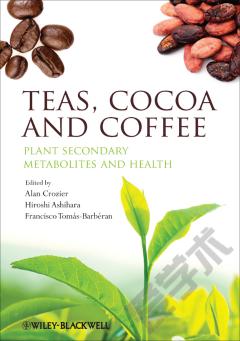Coffee, Tea, Chocolate, and the Brain
This book is the second in the series âNutrition, Brain and Behavior.â The purpose of this series is to provide a forum whereby basic and clinical scientists can share their knowledge and perspectives regarding the role of nutrition in brain function and behavior. The breadth and diversity of the topics covered in this book make it of great interest to specialists working on coffee/caffeine/tea/chocolate research, to nutritionists and physicians, and to anyone interested in obtaining objective information on the consequences of the consumption of coffee, tea, and chocolate on the brain. Coffee is a very popular beverage, the second most frequently consumed after water. Likewise, tea is a fundamental part of the diet of Asian countries and the U.K. and is becoming progressively more popular in Western countries. Chocolate is also widely consumed all over the world. The pleasure derived from the consumption of coffee, tea, and chocolate is accompanied by a whole range of effects on the brain, which may explain their attractiveness and side effects. Coffee, tea, and chocolate all contain methylxanthines, mainly caffeine, and a large part of their effects on the brain are the result of the presence of these substances. As part of this series on nutrition, the brain, and behavior, the present book brings new information to the long-debated issue of the beneficial and possible negative effects on the brain from the consumption of coffee, tea, or chocolate. Most of the book is devoted to the effects of coffee or caffeine, which constitute the majority of the literature and research on these topics. Much less is known about the other constituents in roasted coffee or about the effects of tea or chocolate on the brain. In this book, we have selected world specialists to update our knowledge on the effects of these three methylxanthine-containing substances. Together with a collection of the data on the effects of coffee and caffeine on sleep, cognition, memory and performance, and mood, this book contains specific information on new avenues of research, such as the effect of caffeine on Parkinsonâs disease, ischemia, and seizures, and on the mostly unknown effects of the chlorogenic acids found in coffee. The effects of caffeine on the stress axis and development of the brain are also updated. Finally, the potential for addiction to coffee, caffeine, and chocolate is debated, as well as both the possible headache-inducing effect of chocolate consumption and the alleviating effect of caffeine on various types of headaches. Altogether, these updates and new findings are reassuring and rather positive, showing again that moderate coffee, tea, or chocolate consumption has mostly beneficial effects and can contribute to a balanced and healthy diet. We would like to take this opportunity to thank all the authors for their excellent contributions and cooperation in the preparation of this book.
{{comment.content}}








 京公网安备 11010802027623号
京公网安备 11010802027623号